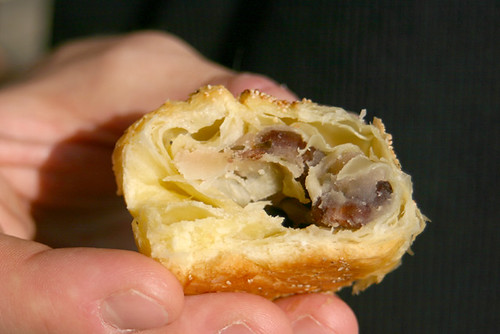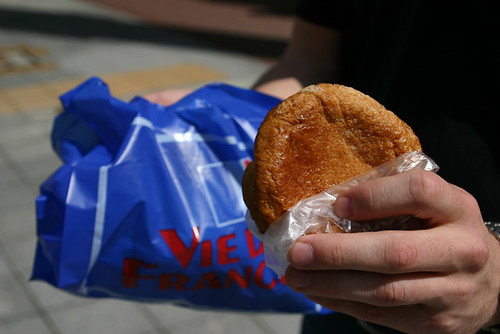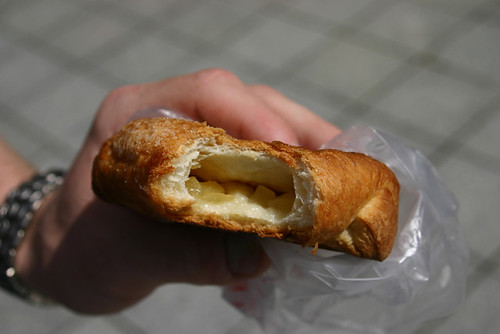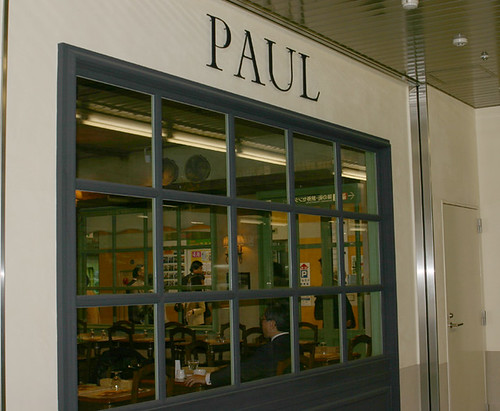When I lived in Japan, I took Japanese bread for granted and didn't appreciate it much. Either that or the increased attention on bread in recent years (most likely due to Yakitate Japain's immense popularity) has elevated the quality of bread in Japan, but during this trip, one of the things that wow'ed me the most was how good the bread was at all the bakeries we stopped and tried. Seriously, I'd say the croissant I had at Vie de France, a chain bakery in Japan, was better than the croissants I had in Paris!
But the best Japains are those that you can't find anywhere else - those breads that are now truly Japanese with Japanese sentiments and Japanese flavors. Anpan, or anko (red bean paste)-filled bread, is a good example of these Japains that you won't find in any European bakeries. What started out as a simple bean-filled bread has grown so much that I found a store in Nagoya dedicated to different varieties of anpan. With creativity and a keen sense of seasonality, this store offered over 15 different kinds of anpan.

This one was made out of cream puff pastry...

...and filled with chunky bean paste (tsubu-an).
Since we were en route to Kyoto when I bought these anpans, they got a little bit squished during our travels...

But they were yummy regardless. The bread was moist and flavorful while maintaining wonderful texture to provide a backbone against the soft anko filling.

The green tea dough was filled with regular anko, while the regular bread dough was filled with either purple potato or sakura (cherry blossom) anko. The sakura anko had some saltiness to it, likely from the chopped sakura leaves, reminiscent of sakura mochi. The purple potato anko had a distinct potato smell to it with a subtle sweetness that didn't overpower the potato aroma or scent. Although anpans have been around for a long time, these new flavors were totally novel to me and I really enjoyed the advances in Japains.

My favorite Japain during this visit were recent additions that I had never had before. Perhaps Cedichou, my French reader, or Sam's Fred can correct my French, since I only know what the Japanese call them, but these breads are called "Kuini Aman" in Japanese, and supposedly, it means "Butter Pastry" in French. Unfortunately, my English-French dictionary does not support this translation (buerre patisserie????).

This 'kuini aman' may have won the Best Discovery from Japan Trip 2005 Award. The outside crust was sweet, buttery, and flaky, almost like a croissant, but this was bread and not a croissant. The inside dough was moist and soft, the way you would expect a bread to be. The contrast of the flaky outside and the moist inside was heavenly. The innards were minced apples that added fruity sweetness to the bread without soaking the bread with juices. This bread was so good, I'd travel back to Japan again just to have another one of these.
The Japanese are serious Francophiles, and they are constantly importing French food into Japan. There seems to have been a new flood of French food in Japan, since there were French-influenced pastries that I didn't remember seeing several years ago in Japan. The Japanese knew exactly what the mystery pastry I had in Paris was, and they were selling canneles everywhere.
I even saw Paul, the ubiquitous French bread shop I saw in Paris.

You can tell this Paul is really in Japan if you look closely at the signs you can see through the window. I didn't eat here, since I was too busy eating my way through Vie de France... I've had my fair share of croissants in the Bay Area, but nothing I've had here comes close to the croissant heaven I was sent to by Vie de France. Goodness, the croissants at Vie de France were oh-so-very good. So good, so good...
8 comments:
the kouign amman effectively is a butter pastry (lots and lots of butter I must say). It is specifically produced in the region of Brittany (la Bretagne) and there's no translation for it, the name is in breton, that is the language that used to be spoken in the area.
Cannelés come from the south ouest of France but you can find them easily around the country unlike the kouign amman.
Buns stuffed with bean paste are some of the great things in the world. Not just among food, but among ALL THINGS. :) Thanks for the photos and yummy commentary.
That looks so good. Bless you, my child.
Marion,
Thank you so much for the clarification on the kouign amman. Now, I can go search google for a recipe!
Robyn,
I agree bean paste buns are so very good, so good that they have become superheros (Anpan-man) in Japan!
Wow, the Pope... Thanks for stopping by my blog!
Hi! It's my first time visiting your blog, but I really like it. I'm a French girl living in Japan and I've been reading Yakitate Japan too! I find it really funny and blogged about it few days ago too. What a coincidence! Anyway, I'll surely drop by your blog again!
Hi, Clea,
Thanks for checking out my blog! Unfortunately, I couldn't understand yours, but I saw the picture of Azuma and Kanmuri from Yakitate #7!!
I hope you're liking living in Japan!
Hi Alice! Thanks for visiting me :) That's too bad you couldn't understand, though. If I make an English version one day, I'll let you know!
Anyway, I love living in Japan, I know I'll miss it when I go back to the world of "pain"...
although i'm not a big fan of the an-pan i do love those pastry shops. last time i was over there i ate two slices of cake in one sitting!
Post a Comment